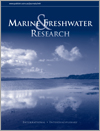MF24172Mitochondrial genetic divergence of Chiton articulatus (Polyplacophora: Chitonida) in the Mexican Tropical Pacific
The chiton Chiton articulatus is an endemic species of the Mexican Tropical Pacific, inhabiting rocky intertidal zones. Its short-lived planktonic larvae limit connectivity among populations across this region. As a result, most localities show clear genetic differences, except for two central sites where populations appear more connected. These findings highlight the need for wildlife managers to consider this genetic structure when developing conservation strategies.





